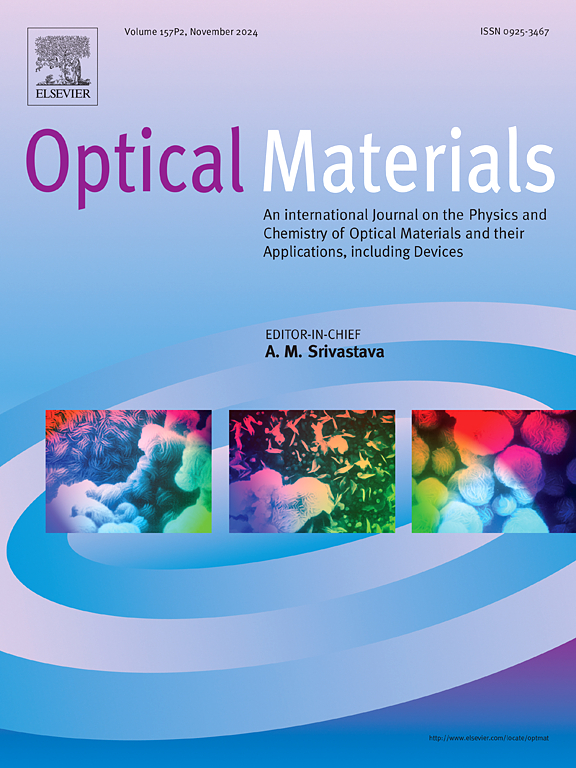Ca3B2O6:Sm3+降移荧光粉的结构、显微结构和光学性质研究
IF 3.8
3区 材料科学
Q2 MATERIALS SCIENCE, MULTIDISCIPLINARY
引用次数: 0
摘要
采用燃烧法制备了荧光材料Ca3B2O6:Sm3+离子,并对其结构、微观结构、表面和光学性能进行了研究。采用x射线衍射和场发射扫描电镜(FE-SEM)对其进行了结构和微观结构分析。用FTIR对其表面进行了分析。利用紫外吸收光谱、光致发光(PL)发射光谱、激发光谱和衰变时间进行光学分析。FTIR分析也证实了BO3基团在其表面存在弯曲振动。进一步,发现宿主的估计能带为5.43 eV。在405 nm激发下,PL Ca3B2O6:Sm3+荧光粉在566 nm、602 nm、651nm和715处表现出明显的发射峰。Dexter认为Ca3B2O6:Sm3+荧光体的浓度猝灭是由偶极-偶极相互作用引起的,而衰减分析表明Ca3B2O6:Sm3+荧光体的衰减时间为τ = 2.0108ms。结果表明,Ca3B2O6: Sm3+可以作为白光固态二极管中产生红色元素的高效荧光粉。本文章由计算机程序翻译,如有差异,请以英文原文为准。

Investigation of structural, microstructural and optical properties of Ca3B2O6:Sm3+ downshifting phosphor
The phosphor material, Ca3B2O6:Sm3+ ions were synthesized using a combustion method and studied their structural, microstructural, surface and optical properties. The structural and microstructural analysis were performed using X-ray diffraction and Field Emission Scanning Electron microscope (FE-SEM). The surface analysis was studied using FTIR. The optical analysis was carried out using UV –absorption,and photoluminescence (PL) emission and excitation spectra, and decay time. Also, FTIR analysis confirmed the presence of bending vibration of the BO3 group on its surface. Further, the estimated energy band of the host was found to be 5.43 eV.The PL Ca3B2O6:Sm3+ phosphor exhibited distinct emission peaks observed at 566 nm, 602 nm, 651 nm, and 715 under excitation at 405 nm. Dexter's suggested the observed concentration quenching was due to the dipole-dipole interaction while the decay analysis depicted that the observed decay time was τ = 2.0108msfor Ca3B2O6:Sm3+ phosphor. The results suggest that Ca3B2O6: Sm3+ can be an efficient phosphor for producing red element in white light solid-state diodes.
求助全文
通过发布文献求助,成功后即可免费获取论文全文。
去求助
来源期刊

Optical Materials
工程技术-材料科学:综合
CiteScore
6.60
自引率
12.80%
发文量
1265
审稿时长
38 days
期刊介绍:
Optical Materials has an open access mirror journal Optical Materials: X, sharing the same aims and scope, editorial team, submission system and rigorous peer review.
The purpose of Optical Materials is to provide a means of communication and technology transfer between researchers who are interested in materials for potential device applications. The journal publishes original papers and review articles on the design, synthesis, characterisation and applications of optical materials.
OPTICAL MATERIALS focuses on:
• Optical Properties of Material Systems;
• The Materials Aspects of Optical Phenomena;
• The Materials Aspects of Devices and Applications.
Authors can submit separate research elements describing their data to Data in Brief and methods to Methods X.
 求助内容:
求助内容: 应助结果提醒方式:
应助结果提醒方式:


